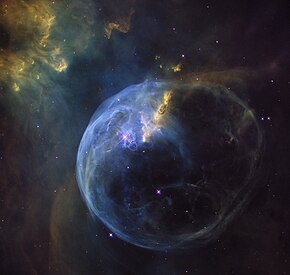Bubble Nebula
| Emission nebula | |
|---|---|
| H II region | |
 Wide field image of NGC 7635 as captured by theHubble Space Telescope | |
| Observation data:J2000epoch | |
| Right ascension | 23h20m48.3s[1] |
| Declination | +61° 12′ 06″[1] |
| Distance | 7100[2]to 11000[3][4]ly(3,400pc) |
| Apparent magnitude(V) | ~10[5] |
| Apparent dimensions (V) | 15′× 8′[6] |
| Constellation | Cassiopeia |
| Physical characteristics | |
| Radius | 3[2]to 5[7][4]ly |
| Notable features | Shell aroundSAO 20575[1] |
| Designations | Bubble Nebula[1] Sharpless162 (Sh2-162) Caldwell11 |
NGC 7635,also known as theBubble Nebula,Sharpless 162,orCaldwell 11,is anH II region[1]emission nebulain the constellationCassiopeia.It lies close to theopen clusterMessier 52.The "bubble" is created by thestellar windfrom a massive hot, 8.7[1]magnitudeyoung centralstar,SAO 20575 (BD+60°2522).[7]The nebula is near a giantmolecular cloudwhich contains the expansion of the bubble nebula while itself being excited by the hot central star, causing it to glow.[7]It was discovered in November 1787 byWilliam Herschel.[5]The star BD+60°2522 is thought to have a mass of about 44M☉.
Amateur observation
[edit]
With an 8-or-10-inch (200 or 250 mm) telescope, the nebula is visible as an extremely faint and large shell around the star.[6][1]The nearby 7th magnitude star on the west hinders observation, but one can view the nebula usingaverted vision.[6]Using a 16-to-18-inch (410 to 460 mm) scope, one can see that the faint nebula is irregular, being elongated in the north south direction.[6]
See also
[edit]Notes
[edit]- ^abcdefgSIMBAD 2007.
- ^abHubbleSite 2000.
- ^Nemiroff & Bonnell 2004.
- ^abNemiroff & Bonnell 2006.
- ^ab"NGC-IC Project Database".Archived fromthe originalon 2001-09-04.Retrieved2008-12-15.
- ^abcdKepple & Sanner 1998.
- ^abcNemiroff & Bonnell 2005.
References
[edit]- SIMBAD(February 23, 2007)."Results for NGC 7635".SIMBAD, Centre de Données Astronomiques de Strasbourg.
- Kepple, George Robert; Sanner, Glen W. (1998).The Night Sky Observer's Guide.Vol. 1. Willmann-Bell, Inc. pp. 108–109.ISBN978-0-943396-58-3.
- HubbleSite(2000)."An Expanding Bubble in Space".
- Nemiroff, R.; Bonnell, J., eds. (July 16, 2004)."The Bubble".Astronomy Picture of the Day.NASA.
- Nemiroff, R.; Bonnell, J., eds. (November 7, 2005)."NGC 7635: The Bubble Nebula".Astronomy Picture of the Day.NASA.
- Nemiroff, R.; Bonnell, J., eds. (October 18, 2006)."NGC 7635: The Bubble".Astronomy Picture of the Day.NASA.
